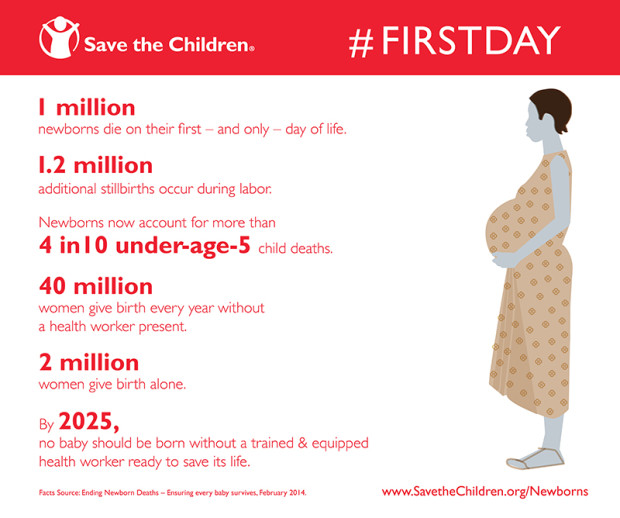22 hours of labor. Contractions two to four minutes apart. Total dilation: 2.5 cm. Final result: an emergency c-section. This was my birth experience with my first son. In situations like these, the mother risks dying in labor and the newborn is more susceptible to succumbing to the stresses of labor as well. Thank goodness we were blessed with our circumstances. I could have easily been one of the millions of women that Save The Children report on, who die every year from childbirth.

Today, 2.2 million first-day deaths and stillbirths happen during labor around the world because of a lack of adequate delivery of health services to pregnant women and newborns. Save The Children has just published its Ending Newborn Deaths Report which calls for the ending of preventable newborn deaths that range in the millions.
There is a crisis in newborn mortality.
Many women and newborns die because they are poor. Many newborns die because they are not receiving adequate care when they enter this world. Many newborns die because of a global shortage of midwives and other health workers at birth. These are just some of the contributing factors to the high preventable newborn mortality rate.
Startling Numbers
Here are some of the figures from the Save the Children report:
- 2 million newborn babies could be saved each year if we end preventable newborn mortality.
- 1 million babies did not survive their first – and only – day of life in 2012.
- 2.9 million babies died within 28 days of being born in 2012. The number is disproportionately higher in Africa than in Europe, 4:1.
- 6.6 million children died before their fifth birthday in 2012, mostly from preventable causes. Although the number is half of what it was in 1990, 18,000 children died every day.
- The world is short 7.2 million midwives, nurses, and doctors to address the need for skilled workers.
- There were 1.2 million stillbirths (when the heart stops beating during labor) in 2012.
- 40 million women across the world give birth each year without any help from a midwife or other trained and equipped health worker. 2 million women report that when they last gave birth they were completely alone. What a scary thought.
- Universal coverage of skilled qualified birth attendance could be achieved by 2025 if we double the current rate of progress. If the rate doesn’t increase, this won’t be achieved until 2043 and millions more will not live to see past their first day.
Global Responsibilities
The fourth UN Millennium Development Goals set a 2015 deadline to reduce child mortality by two-thirds. The world is off track. Save The Children is calling on world leaders, governments, philanthropists, and the private sector to tackle the crisis of newborn deaths by implementing a five-point Newborn Promise to end all preventable newborn deaths. Essentially, each one of these actors are being called upon to take onus in specific responsibilities.
Here’s a brief snapshot of a few of the actions Save The Children is asking of governments and the private sector:
Governments – increase expenditure on heath care; remove user fees for all maternal, newborn and child health services.
Private Sector – develop innovative solutions and increase availability for the poorest to new and existing products for maternal, newborn and child health.
Read the Ending Newborn Deaths report here: http://bit.ly/1etoqWw
Get a better idea of the crisis that the world is facing and spread the word by sharing this post or the link to the report via email, Facebook, Twitter, etc. The only way we can enact change is by creating awareness and consequently pressure.
Every child deserves to live when their death can be prevented.
This post was written as part of the Global Team of 200, a highly specialized group of Mom Bloggers for Social Good members who focus on maternal health, children, hunger, women and girls.
Leave a Reply